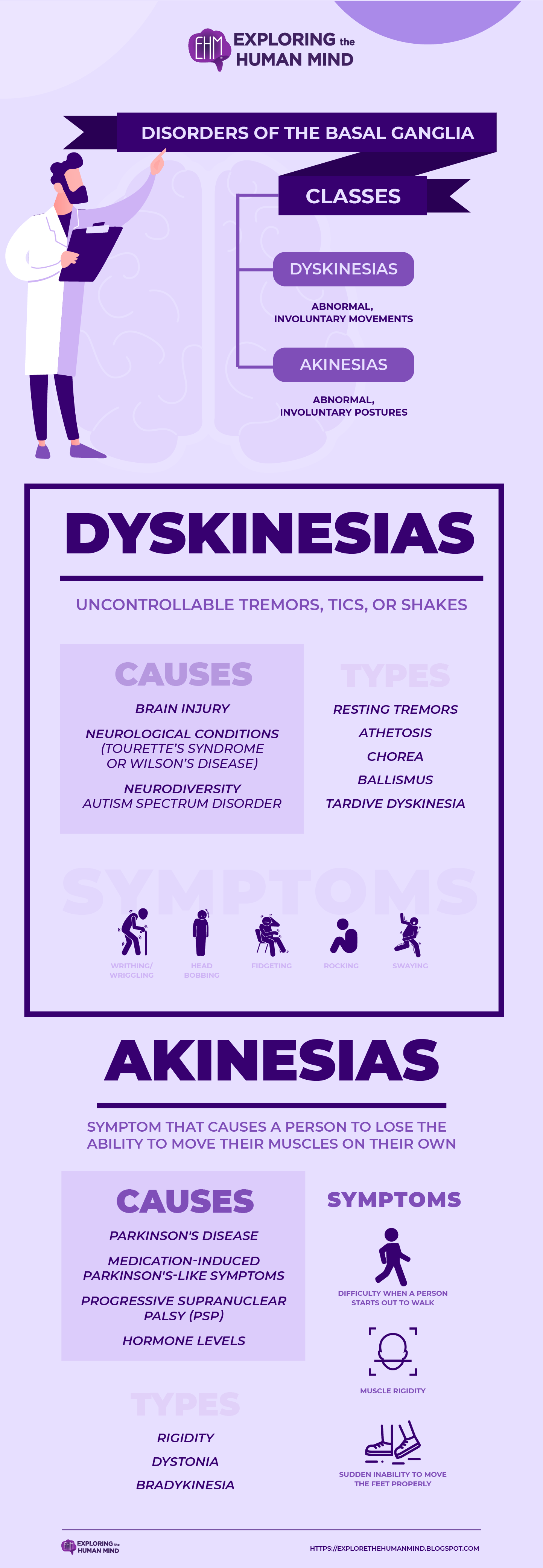Disorders of the Basal Ganglia Classes
- dyskinesias, which are abnormal, involuntary movements, and
- akinesias, which are abnormal, involuntary postures.
These symptoms are known as extrapyramidal disorders because the basal ganglia were once thought to make up a distinct, "extrapyramidal" motor system.
Dyskinesias
A movement disorder called dyskinesia frequently manifests as uncontrollable tremors, tics, or shakes. The condition frequently affects people with Parkinson's disease as a result of their dopamine receptors being overstimulated by drugs that elevate this neurotransmitter in the brain.
Tardive dyskinesia is a different kind of dyskinesia that develops after taking specific drugs that block dopamine receptors. The word "tardive" refers to a delayed occurrence, and doctors use it to describe the type of dyskinesia that typically results from taking such drugs over an extended period of time.
Possible causes of dyskinesia include:
- brain injury
- neurological conditions such as Tourette’s syndrome or Wilson’s disease,
- neurodiversity, such as autism spectrum disorder.
The main sign of dyskinesia is involuntary movement. This may only affect one area of the body, like an individual's arm or leg, or it may affect the entire body.
Common symptoms include: writhing or wriggling, head bobbing, fidgeting, rocking, swaying.
Types
- Resting tremors are most often associated with Parkinson’s disease. When the patient is at rest, certain body parts will display a 4-7 Hz tremor. For example, the thumb and forefingers will move back-and-forth against each other in a characteristic tremor called “pill-rolling tremor.” The tremor stops when the body part engages in active movement.
- Athetosis is characterized by involuntary, writhing movements, especially of the hands and face.
- Chorea, which derives from the Greek word for “dance,” is characterized by continuous, writhing movements of the entire body. It is viewed by some as an extreme form of athetosis. Chorea is most closely identified with Huntington’s disease.
- Ballismus is characterized by involuntary, ballistic movements of the extremities.
- Tardive dyskinesia can result from the long-term use of antipsychotic drugs that target the dopamine system. It is characterized by involuntary movements of the tongue, face, arms, lips, and other body parts. It is thought to occur as the result of an imbalance between the D1 and D2 receptors, thereby favoring the direct pathway over the indirect pathway.
Akinesias
Akinesia is a symptom that causes a person to lose the ability to move their muscles on their own. Sometimes a person's body feels "frozen" in time.
Some of the symptoms associated with akinesia include:
- Difficulty when a person starts out to walk
- Muscle rigidity, usually beginning in the neck and legs. Muscles in the face can become rigid, similar to a mask
- Sudden inability to move the feet properly
In adults, some of the causes associated with akinesia include:
- Parkinson's disease: This causes the brain to produce less dopamine, impairing a person's ability to control their muscles
- Medication-induced Parkinson's-like symptoms: When a person takes too much of a dopamine-inhibiting medication
- Progressive supranuclear palsy (PSP): A gradual brain-damaging condition that usually first affects balance while walking
- Hormone levels: Hypothyroidism, or extremely low thyroid hormone levels.
Men with Parkinson's disease are more likely than women to experience akinesia. The likelihood of developing akinesia is lower in people with Parkinson's disease who have a resting tremor as their main symptom.
Types
- Rigidity is a resistance to passive movement of the limb. Unlike spasticity, rigidity does not depend on the speed of the passive movement.
- Dystonia is the involuntary adoption of abnormal postures, as agonist and antagonist muscles both contract and become so rigid that the patient cannot maintain normal posture
- Bradykinesia refers to slowness, or poverty, of movement.

vectors by Freepick; graphic design by Vadot
Reference:
Disorders of the Motor System (Section 3, Chapter 6) Neuroscience Online: An Electronic Textbook for the Neurosciences | Department of Neurobiology and Anatomy - The University of Texas Medical School at Houston. (2020). Tmc.edu. https://nba.uth.tmc.edu/neuroscience/m/s3/chapter06.html
Huizen, J. (2017, October 19). What you need to know about dyskinesia. Medicalnewstoday.com; Medical News Today. https://www.medicalnewstoday.com/articles/319744#types-and-causes
Nall, R. (2017, December 10). What is the definition of akinesia? Medicalnewstoday.com; Medical News Today. https://www.medicalnewstoday.com/articles/320291#risk-factors-for-akinesia






Comments
Post a Comment